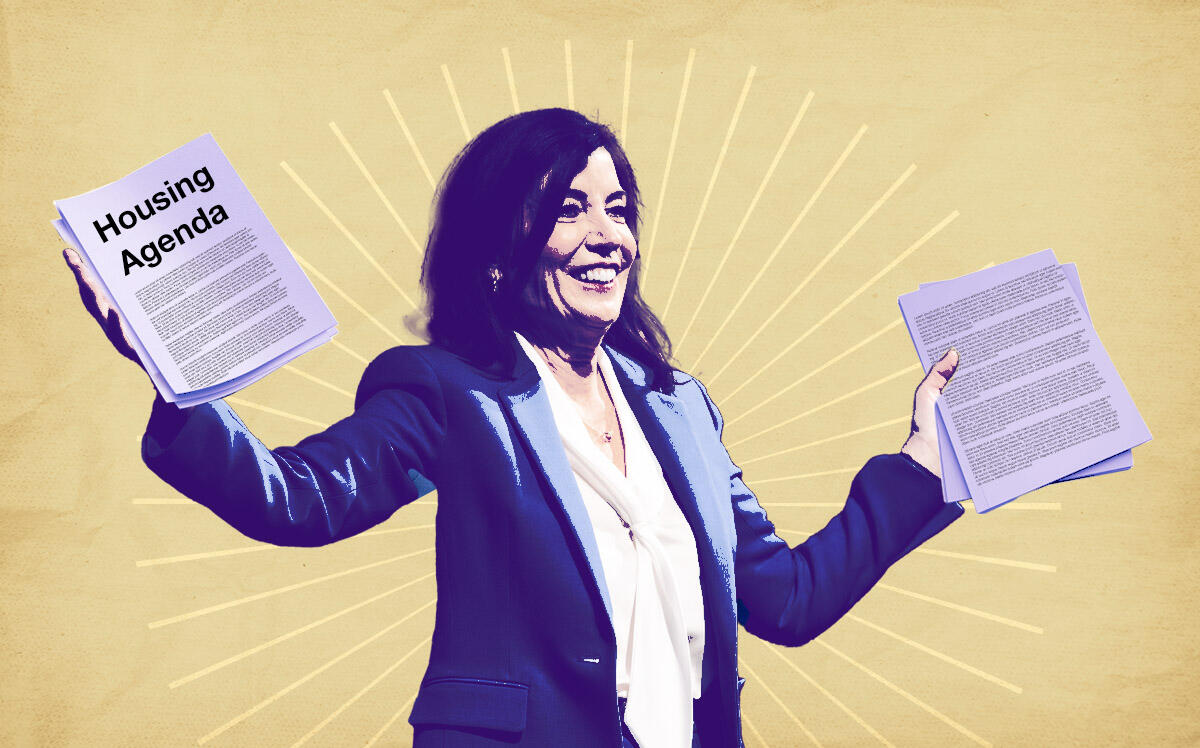Everyone hates politics, even the people who also love it. Politics just seems to kill good ideas more easily than it promotes them.
Take Gov. Kathy Hochul’s housing agenda. If its fate rested on logic alone, it would pass as soon as she printed the bills. Getting the policy right is easy. It’s the politics that are hard.
Moments after Hochul announced her plan on Jan. 10, Assembly member Edward Flood, a Long Island Republican, tweeted, “Her goal is to turn Brookhaven into the Bronx.”
Governor Hochul’s housing proposals would be a disaster for our community.
Her goal is to turn Brookhaven into the Bronx by removing local control of zoning laws and force 3% growth in down state areas.
Hard pass!
— Edward Flood (@Eflood29) January 10, 2023
Yimbys promptly excoriated the rookie politician for his comment’s thinly veiled racism and Neanderthal thinking, but his messaging will resonate with his Nimby and Trumpy constituents.
Look at what happened a year ago, when Hochul first broached some of the housing proposals outlined in her State of the State address last week. Her enemies went on the attack, saying she was ramming policies down the throats of localities. Rather than risk her re-election, she dropped her bills like a sack of potatoes.
Now, with a four-year term ahead of her and New York still bleeding population, she’s trying again. Here’s a look at why her housing ideas will either succeed or fail.
Replacing 421a
Why it will fly:
Rather than pitch a tax break for New York City rental projects that progressives would bash like a pinata, as they did last spring, Hochul said she would work with the legislature to come up with one.
That looks like a cop-out, but it’s actually smart. Giving legislative leaders ownership of the plan will give them reason to pass it. Asking them to twist their members’ arms for a plan with Hochul’s name on it was hopeless, even though her bill was more progressive than the program it sought to replace, 421a, which expired in June.
Apartment construction has more momentum now, too, thanks to Mayor Eric Adams and City Council Speaker Adrienne Adams getting behind it. And the City Council approved a massive, 45 percent affordable housing development in Astoria that depends on a property tax break. So does most of the housing promised by the Soho, Gowanus and Inwood rezonings, among others.
Why it will flop:
Haters of 421a will trash any new version of the tax break as lipstick on a pig and insist that developers can live without it — especially if owners of development sites slash their prices on the belief that 421a is gone for good.
A revised version won’t win over detractors because its essence will be that of the old 421a: A long freeze on property taxes for multifamily development with a percentage of units set aside as affordable. Critics reject that premise, arguing that the tax break doesn’t net enough affordable housing.
They prefer to subsidize affordable units with tax dollars, but Hochul has already pledged $5 billion a year and doesn’t have enough money to build all the housing New York needs.
With Senate Democrats divided on the issue and unwilling to pass anything that requires Republican votes, talks between Hochul and Senate Majority Leader Andrea Stewart-Cousins and moderate-cum-progressive Sen. Michael Gianaris will hit an impasse.
Office-to-resi conversions
Why it will fly:
Chuck Schumer would rather New Yorkers not remember that after 9/11 he called for keeping the Financial District office-centric, and for the most part, they have forgotten. Making Lower Manhattan a live-work-play area was a rousing success, and these days, everyone wants offices to be turned into housing. Hochul’s ideas to ease that process should pass without much fuss.
The blueprint for conversions already exists, and it’s simple enough to expand eligibility by including buildings constructed before 1991. No one will object to the governor’s suggestion to provide a tax break to conversions that include affordable housing. Mayor Eric Adams is on board; he unveiled a similar plan just before Hochul.
The stars are aligned.
Why it will flop:
Politicians are fairly clueless about the economics and logistics of converting office buildings into residences, and demonstrated as much by passing two Covid-era conversion bills that accomplished absolutely nothing.
The risk with Hochul’s plan is not that the eventual bills won’t pass, but that they won’t work. How many politicians know that provisions in the city code intended to make housing more humane (a window in every bedroom, units no smaller than 400 square feet, no communal bathrooms, etc.) also make it more expensive? Do they even understand the implications of large floor plates?
It’s also conceivable that progressives will demand so much affordability in projects as to render them impossible to finance. Stewart-Cousins hasn’t been inclined to muscle her members into addressing the housing crisis the way Speaker Adams has in the City Council.
Read more


Lifting the residential density cap
Why it will fly:
It makes no sense to limit the density of residential but not commercial buildings in Manhattan. But New York has done exactly that for decades. The 1961 zoning code reduced the city’s housing capacity by 78 percent from its original, 1916 zoning. That has helped prevent housing development from keeping up with demand.
Explaining the rationale for lifting the cap on floor-area ratio for apartment projects should not be hard. Two students did it easily enough in this op-ed.
Why it will flop:
Some Manhattan representatives and activists don’t like tall buildings. Which is like people in Alaska bitching about cold weather, except that the Manhattanites can actually do something about their pet peeve.
The Municipal Art Society even started a campaign in 2013 called “the Accidental Skyline,” as if Manhattan hadn’t had one for 80 years. Does anyone really think the skyline that has long been the envy of the world was carefully planned?
These folks know a thing or two about defeating bills. And given that last year Hochul proposed lifting the FAR cap and got nowhere, repeating failures of 2016, 2018, and probably some other years, it could certainly happen again.
Legalizing basement apartments
Why it will fly:
For ages, New York politicians could overlook that untold thousands of their constituents lived in illegal basement dwellings. Then a dozen of them drowned in Tropical Storm Ida.
Creating a path to legalization of such units before the next torrential rain would spare elected officials the shame of allowing another tragedy. It would also raise tax revenue, bolster tenants’ rights and create construction jobs.
Separating the basement bill from one that permits accessory dwelling units in the suburbs would enhance its chances of passing. Hochul could do that, unless she combines the measures in order to get city votes for the suburban bill.
Why it will flop:
Not a year goes by without a politician proposing to legalize basement units. Nothing ever happens.
Bill de Blasio got the furthest, actually starting a pilot program, which led to the price tag for citywide legalization being estimated at $14 billion.
Basement apartment dwellers are among the city’s most powerless people. Who is going to spend $14 billion for them?
Builder’s remedy
Why it will fly:
This is the hardest of Hochul’s agenda items to handicap because nothing like it has been attempted in New York. But the concept of builder’s remedy — a way to get projects through when a town unjustly rejects them — exists in other states.
Reporter Trevor Bach’s feature on California’s law is a must-read for industry professionals, housing activists and government officials alike.
Hochul’s version attempts to split the difference between the status quo — which is letting localities block new housing as much as they want — and the state taking over zoning from them.
Towns and cities must meet Hochul’s housing targets or, alternatively, encourage new housing by upzoning, legalizing granny flats or taking other steps. If they do neither, projects with more than 20 units and adequate affordability can proceed, local zoning be damned, unless there are health and safety issues. A state-level appeals process will decide that.
Municipalities with LIRR or Metro-North stations would have to rezone areas within half a mile of them to allow at least 25 homes per acre.
Hochul demands only modest housing growth and gives localities flexibility, so she can sell it as a reasonable way to reverse New York’s population loss and stem housing costs.
Why it will flop:
Explaining the plan to New Yorkers, even though it took only four sentences above, will be far more challenging than scaring them into opposing it, as Assembly member Flood is trying to do.
People’s eyes glaze over when they hear terms like zoning and accessory dwelling units. But mention low-income housing, high density and dog-whistle phrases like “we’ll become the Bronx” and out come the pitchforks.
Even if builder’s remedy passes, towns and local groups could tie up projects in bureaucracy and litigation until the next governor comes along.
